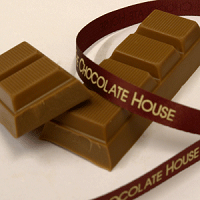Great stuff chocolate, very, very few people don’t like it and I would guess it must be about the most universally accepted flavour. It is also a huge subject – after about forty years in the industry I have come to the conclusion that experience just proves how little, rather than how much, you know about the subject.
I won’t pretend that this article is in any way definitive, it is aimed at introducing some of the interesting features to those who like chocolate and might be interested in learning a little more about it. Apologies to any colleagues who find the lack of detail frustrating, but they will know that it would need a book to even scratch the surface of the subject. More technical stuff in later blogs!
Let’s dispose of one myth to start with – the “best” chocolate is the one you like best, and very often the one you were given as a child, although people do often gravitate from white chocolates which tend to be very sweet to milk or dark recipes as they get older. The strong influence of childhood memory (even when it is unconscious) explains why, for example, people in UK like typical UK chocolate with its caramel notes which people in Europe generally dislike – it all depends what you were brought up on. For me personally it is Poulain chocolate from France and Irish Cadbury Dairy Milk – why? – well I had a lot to do with both and got seduced.
Chocolates have remarkably few basic ingredients and within the EU there is an excellent legislative framework defining chocolate. Basically chocolates can contain the fat and solids from cocoa beans, milk products and sugars. In addition they can contain flavours and emulsifiers and up to 5% added vegetable fats
What then defines the “quality” of a chocolate – broadly – and as with all food products – the quality of the raw materials and following that a fine particle size and the excellent mouth feel, which results from good conching. Of course various small and obscure cocoa sources will influence the exact flavour, and many well known brands contain cocoas from several sources, but to most people chocolate is a source of pleasure and indulgence – coupled with its strong “gift and share” element – not something to be analysed like a rare wine. As with all foods there is a role for niche products, but it does not necessarily make them “better”.
Traditionally UK and Irish milk chocolate has always been higher in milk solids and a little sweeter than many European recipes – it is a matter of consumer preference, because although European recipe chocolates have a niche in the UK market, the massive preference is for the traditional products of Cadbury, Nestle, Mars, etc. To make a tonne of UK milk chocolate requires about 625 (2800l) gallons of milk, so chocolate is a significant customer of the dairy industry and that chocolate contains a lot of good nutritional ingredients.
It has become something of a fashion statement to “prefer” higher cocoa solids chocolates and a degree of horror is sometimes expressed about vegetable fats added to chocolate
There is some justification in using high cocoa solids products in cooking, but apart from that just be honest about what you prefer. A lot of high cocoa solids chocolates are not actually that wonderful and the quality of the cocoa products going in to the product and the way it is produced has as much influence on the flavour as the absolute cocoa solids content. Some Swiss and Belgian chocolates are extremely bland, tasting of sugar and milk powder and not much else – it’s what happens when you have to treat poor quality cocoa to remove off flavours – so lots of “cocoa solids” for the image but not much flavour.
Then there is the addition of vegetable fats, limited by EU regulation to 5%. Cocoa butter is a challenging fat, particularly when mixed with milk fat, (it has at least six different crystal forms, for example, only one of which is stable). The great advantage of adding other fats is their consistency and their ability to compensate for the softening effect which milk fat has on cocoa butter which is a significant issue with UK high milk content chocolates. The vegetable fats added are generally fractions of palm and shea fats – not hydrogenated – and are added for technical rather than purely financial reasons.
Perhaps the major difference between milk chocolate in UK and Ireland and that in the rest of Europe is the way in which milk is incorporated into the chocolate. In the UK most milk chocolates are produced by incorporating liquid milk into the recipe before removing the water. In Europe the milk is generally added in the form of milk powder. This results in a more pronounced “caramel” note in traditional UK milk chocolates (for example Cadbury) produced not only in UK and Ireland, but also wherever in the world there is a strong tradition of this type of chocolate – countries such as Australia, South Africa, and India.


